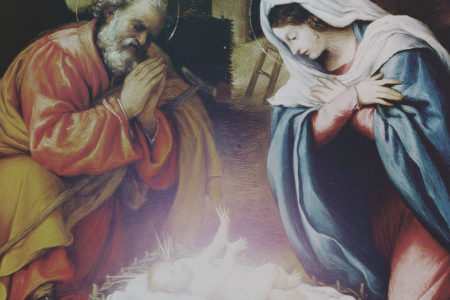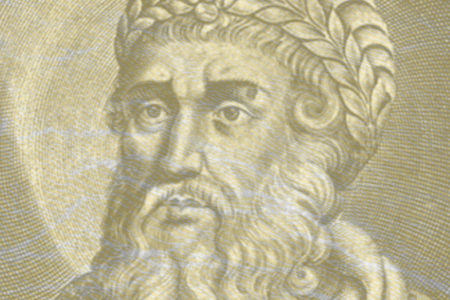The Men from the East
They studied astronomy, astrology, philosophy, religion, and sorcery, among other things. Yet they traveled almost 1,000 miles to worship the newborn King of the Jews. Who were the magi? And what was the star they followed?
The story of the wise men, or magi, is one of the most interesting and captivating accounts recorded in the Bible. Countless Christmas cards, carols, and plays present the story of their journey to see Jesus, the one “born King of the Jews” (Mt. 2:2). But often such narratives fail to accurately represent the biblical account.
The Bible never provides the number of wise men or identifies them as kings or says they came from the Orient or states they visited Jesus while he was a baby in a stable, surrounded by shepherds, sheep, and camels.
So what does Scripture reveal about the magi and their journey to see the Christ Child? It reveals quite a bit, actually.
Who Were the Magi?
The Bible first mentions the magi in Matthew 2:1–2: “Now after Jesus was born in Bethlehem of Judea in the days of Herod the king, behold, wise men from the East came to Jerusalem, saying, ‘Where is He who has been born King of the Jews? For we have seen His star in the East and have come to worship Him.’”
Of the four gospels, only Matthew records the magi account. This fact makes sense since the they were seeking the one “born King of the Jews” (v. 2; cf. 21:4–5; 27:11, 29, 37), and Matthew was writing to the Jewish people.
The phrase wise men comes from the Greek word magoi, which is “magi” in English. The magi lived in the seventh century BC in the Median Empire, which eventually became part of the Persian Empire. The magi later spread into Babylonia, Arabia, and other countries.
They were priests who dressed in all white, offered sacrifices, developed occult powers, and used divining rods for various purposes. They studied and practiced astronomy, astrology, philosophy, religion steeped in superstition, sorcery (cf. Acts 13:6, 8), soothsaying, conjuring, and dream interpretation—a practice mentioned in the book of Daniel during the time of the Babylonian Empire (Dan. 1:20; 2:2; 4:7; 5:7). As astronomers who practiced astrology, they believed the stars and planets influenced human life.
This marvelous story of the magi reveals how God worked to announce the Messiah’s birth to the Gentile world and presents a wonderful illustration of men from an ungodly culture desiring to know and worship the one true God.
God stirred the magi’s hearts to seek and find the King of the Jews, just as He called Abraham to leave his home country of Ur and go to a land He promised to show him. God promises that anyone who earnestly seeks Him will find Him (Jer. 29:13; Mt. 7:7).
Τhe Magi’s Journey and Arrival
The magi came “from the East” to Jerusalem (Mt. 2:1). The journey (900 to 1,000 miles) probably took many weeks. Scholars believe more than three magi made the trip and that, for most of the trip, they probably didn’t ride on camels, which were considered animals of burden.
Their journey raises a number of questions: How did these men know to ask, “Where is He who has been born King of the Jews?” (v. 2). Why would they make a long, hazardous trip to worship a baby? What made them think Jesus was in Jerusalem? And what was the makeup of the star they saw in the East?
The magi may have heard about a king of the Jews from the Jewish people who remained in Babylon after Israel’s release from captivity, and they may have read of the prophetic expectation of Israel’s coming King: “A Star shall come out of Jacob; a Scepter shall rise out of Israel” (Num. 24:17).
The word scepter speaks of kingship. Magi believed an extremely bright star indicated the birth of a king, so the special star probably alerted them to the Jewish prophecy. They had access to the book of Daniel and other prophetic Scriptures that described the Messiah’s appearance (Dan. 9:24–27), place of birth (Mic. 5:1–2), and kingly rule (Isa. 9:7).
The prompting of the Holy Spirit and the realization that a king of Jesus’ magnitude and greatness had been born probably motivated the magi to make the long trip. They knew to head toward Jerusalem because of the star’s leading.
The Star
We know the following details concerning the Star of Bethlehem:
1. It appeared and disappeared.
2. The magi called it “His star,” indicating its connection to Jesus (Mt. 2:2).
3. It appeared in the East then moved west toward Israel.
4. It appeared twice.
5. It led the wise men to a specific house in Bethlehem (v. 9).
6. It most likely appeared to them the night Jesus was born.
Commentators have speculated the star might have been a nova, supernova, comet, or an alignment of planets. In 1603, astronomer Johannes Kepler reported seeing an unusual conjunction of Jupiter and Saturn in Pisces and, through extensive studies, found that the same conjunction of planets was seen around 6 BC, approximately the time of Jesus’ birth.
But biblical scholars do not believe these natural explanations adequately explain the scriptural data. Scripture suggests the Star of Bethlehem was not a natural stellar phenomenon but, rather, a special star created by God for the unique purpose of guiding the wise men to Jesus.
If the Star of Bethlehem had been a mere natural star, the magnitude of it would have destroyed life on Earth. Its intense brightness radiated the brilliance of God’s glory, often called the Shekinah Glory of God. Such was the case when an angel announced Christ’s birth to shepherds, and “the glory of the Lord shone around them” (Lk. 2:9).
In addition, stars naturally move from east to west due to the earth’s rotation. But Scripture says the Star of Bethlehem moved from Jerusalem to Bethlehem—north to south. Scripture also says the star “went before them, till it came and stood over where the young Child was” (Mt. 2:9). Natural stars never stop moving, nor do they lead people to a particular location.
Herod’s Wicked Plot
After the magi reported to King Herod why they had come to Jerusalem, Scripture says Herod “was troubled, and all Jerusalem with him” (v. 3).
The word troubled means Herod was shaken to his very core. Herod the Great was paranoid and suspicious, mistrusting everyone around him, especially when it came to his position as king. His insecurity led him to murder three of his sons, his wife Mariamne, and 300 of his officers. The citizens of Jerusalem feared his brutality.
Herod feared losing his crown since he was not born Jewish nor was he a descendant of King David. Herod was an Idumaean (Edomite), appointed by Roman General Mark Antony to become tetrarch of Galilee in 37 BC. Later the Roman Empire appointed Herod king over Judea, and he became known as Herod the Great for his massive building projects, including the splendid Temple in Jerusalem named after him. The magi’s inquiry fed Herod’s paranoia of a competing king, so he took immediate action:
And when he had gathered all the chief priests and scribes of the people together, he inquired of them where the Christ was to be born. So they said to him, “In Bethlehem of Judea, for thus it is written by the prophet: ‘But you, Bethlehem, in the land of Judah, are not the least among the rulers of Judah; for out of you shall come a Ruler who will shepherd My people Israel’” (vv. 4–6; cf. Mic. 5:2).
The Jewish leaders—the Sanhedrin, high priests, scribes, and elders—knew the Micah 5:2 prophecy and told Herod where the Messiah would be born. Notice, these spiritual leaders of Israel knew the prophecies about the Messiah’s birth but made no attempt to travel five miles from Jerusalem to Bethlehem to see whether the “King of the Jews” had been born. Amazing!
Aware of the prophecy, Herod wasted no time. He “secretly called the wise men, [to learn] from them what time the star appeared” (Mt. 2:7). Then—in a cunning, deceptive, and diabolical move—he sent the wise men to Bethlehem, saying, “Go and search carefully for the young Child, and when you have found Him, bring back word to me, that I may come and worship Him also” (v. 8). Herod had no intention of worshiping Jesus; he wanted to murder Him—and probably His family too.
Immediately after the magi departed for Bethlehem, “the star which they had seen in the East went before them, till it came and stood over where the young Child was. When they saw the star, they rejoiced with exceedingly great joy” (vv. 9–10).
The magi were amazed and overjoyed to see the star appear to guide them again, not only to Bethlehem but also to the exact house where Jesus dwelt. Though their entire trip—from the East to Bethlehem—probably took several months, the final destination was worth it.
The Magi’s Adoration
Matthew wrote, “And when they had come into the house, they saw the young Child with Mary His mother, and fell down and worshiped Him. And when they had opened their treasures, they presented gifts to Him: gold, frankincense, and myrrh” (v. 11).
This passage makes it clear Jesus’ family was no longer dwelling in a stable or cave but in a house. As the magi entered, they immediately fell on their faces and worshiped the Baby. They gave themselves to Him before presenting their gifts.
After adoring Him, they opened their treasures and gave Jesus gifts specifically fit for a king of that day. In Scripture, gold symbolizes God’s deity, glory, and majesty; frankincense symbolizes the fragrance of Jesus’ life; and myrrh symbolizes Christ’s sacrifice, death, and burial.
Before the magi left, God warned them in a dream not to return to Herod: So they “departed for their own country another way” (v. 12).
Soon afterward, God also warned Joseph in a dream to flee Bethlehem: “Now when they [the magi] had departed, behold, an angel of the Lord appeared to Joseph in a dream, saying, ‘Arise, take the young Child and His mother, flee to Egypt . . . for Herod will seek the young Child to destroy Him’” (v. 13). Joseph obeyed and fled with his family that night.
We can learn many lessons from the story of the magi. First, God included the most unlikely Gentiles in revealing the birth of His Son to the world, reminding us God is no respecter of persons and desires all people to come to the knowledge of the truth (cf. Acts 10:34; 1 Tim. 2:4). Second, God guided the wise men to Bethlehem in a miraculous way, which teaches us of God’s power. And third, God orchestrated every aspect of the affairs of man to accomplish His will, reminding us of His sovereignty.









Very informative indeed.
Awesome article and very insightful.